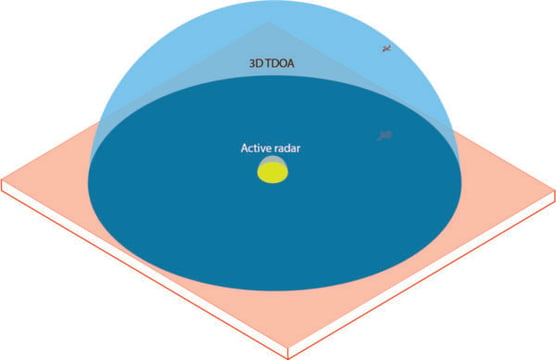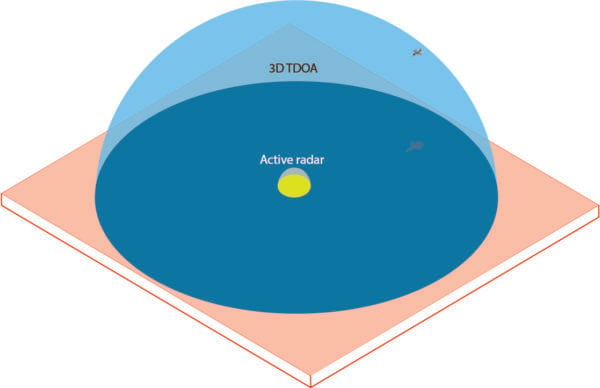
Radar is a tried and trusted method of monitoring aircraft activity in the surrounding area. It is also, in certain circumstances, a blaring beacon advertising its own location to enemy forces. Let’s have a look at how 3D TDOA can be used to circumvent this problem, when deployed as a complement to radar systems.
Types of Radar System
First of all, we’ll need to have an idea what the different types of radar systems available are. There are various ways to characterise these systems (including operational frequency, pulse characteristics or intended application), but for our purposes here, the key distinction is between active and passive radar systems.
Active radar systems generate and transmit their own RF pulse, and then receive and measure the reflected signal at the same location. Transmitting a signal in this way has two major drawbacks: firstly, it can alert enemy pilots that their location is being tracked, and secondly, geolocation techniques such as TDOA can be used on the signal to determine its point of origin. Armed with this information, enemy forces could take steps to disable the radar station.
Passive radar systems, by contrast, do not produce their own RF transmissions. Instead, they rely on RF transmissions that have been produced independently for another use (for instance, digital TV (DVB-T), digital radio (DAB), FM radio or mobile phone (GSM) signals). This has the obvious advantage of allowing for undetectable monitoring of aircraft. It may also be useful for monitoring stealth aircraft, which are designed to be invisible to standard radar frequencies, but may be visible to the different frequencies used for these applications. It does, though, introduce significant complications into the radar setup. As the transmitter and receiver are no longer at the same location, the accuracy of the system becomes limited by how well the propagation paths between emitter, target and receiver can be modelled. The system also relies on a broadcast signal that is not under the radar operator’s control, which means it will not be optimised for use with radar, and cannot be relied on to continue transmitting when required.
A partial compromise between the use of active and passive systems is a bistatic radar, in which a dedicated radar transmitter is placed at a distance from the receiver station. This allows the receiver station to remain undiscovered, even if the source of the transmission is located. As the emitter and receiver are at different locations, the accuracy will still depend on how the wave paths are modelled, although as the emitter location can now be chosen by the radar operator, this can be done so as to minimize any loss of accuracy. Bistatic radar is still susceptible to enemy action, as even though the receiver station remains covert, the transmitter location could be determined, and the transmitter disabled.
TDOA – providing the strengths of active and passive systems
So how can we get the best of both worlds, and covertly track enemy aircraft without relying on infrastructure that we do not control? The answer lies in combining a 3D TDOA capability with a short-range active radar. The characteristics of the two systems ensure that they work well together in tandem, particularly for weapons-control type applications. In these circumstances, the highest possible accuracy is required from the radar, which means that a high-frequency system (typically K-band) is needed. The trade-off for high precision with these types of radar is a short operating range (roughly speaking, tens of kilometres). This does, though, mean that the radar cannot be detected beyond this range either. To extend the range at which aircraft can be monitored without compromising covertness, a passive 3D TDOA network is used to monitor a much wider area. Because the aircraft are being monitored using their own RF transmissions, its use cannot be detected by these aircraft. Their approach can be tracked with good accuracy, right up to the point that they enter the range of the radar system. To increase covertness even further, the radar system can be engaged only at this point, rather than continuously monitoring. The combined system will look something like the setup below, with a small actively-monitored centre surrounded by a large passively-monitored area. The geometry of the surrounding area need not be circular though – its layout can be determined by the placement of the TDOA system Nodes.

Want to know how TDOA works? Download the 3D TDOA whitepaper here
Example applications of combined system
Fire Control
This kind of combined radar/TDOA system is ideal for use with anti-aircraft weapons systems, that require high accuracy to be effective. In this scenario, incoming aircraft are passively tracked using 3D TDOA as they approach the radar station, meaning they are not aware of its location. As the aircraft reach the optimal range for use of anti-aircraft missiles, the fire-control radar systems can be engaged at the last possible moment, allowing for precise missile targeting. At this stage, even if the enemy aircraft becomes aware of the location of the radar station, it will be too late to take evasive action.
Continuous Covert Tracking
3D TDOA also allows continuous tracking in situations where active radar cannot be used, either in order to remain fully covert, or to avoid radar emissions interfering with other signals (for instance, in test scenarios when tracking your own forces’ RF emissions from aircraft to tactical radios).
Locating Radar Jammers
A combined radar/TDOA system also has potential uses even in a situation where covertness is not key. Consider an active radar that has been deployed, but has been rendered ineffective through the use of a radar jammer. The jammer works by effectively flooding the area around the radar with RF transmissions, meaning the radar echoes cannot be picked out from the noise. That means that the jammer itself is sending out an overwhelmingly large RF signal, that can be easily located using TDOA. The jammer can then be targeted and neutralised, allowing the active radar to function as desired.
Detecting Stealth Aircraft
This is, admittedly, unlikely to be a regularly employed scenario, as pilots of stealth aircraft will be highly reluctant to lose the advantage of being virtually invisible to radar by announcing their position through RF transmissions. Nevertheless, on the rare occasions that circumstances force them into employing communications systems, having a TDOA system in addition to radar will allow their location to be pinpointed.
Next Steps
Want to discuss adding TDOA capability to supplement your existing radar setup? Get in touch with us here at CRFS, and one of our team will be happy to help. If you would like to know more about how 3D TDOA works, then download our 3D TDOA White Paper here.

White paper
Passive geolocation with 3D TDOA
This white paper addresses the basic operating principles of 3D TDoA; Practical limitations on its accuracy; Applications of the technique.
